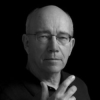Sam Abell

Sam Abell
Sam Abellis an American photographer known for his frequent publication of photographs in National Geographic. He first worked for National Geographic in 1967, and is one of the more overtly artistic photographers among his magazine peers. Sam Abell's style of photography is documentary in the sense that his major avenue, the National Geographic magazine, is a publication of record. However, his best work is known for its transcendent qualities, starting at the documentary level yet open to interpretation on an...
NationalityAmerican
ProfessionPhotographer
CountryUnited States of America
For spiritual companions I have had the many artists who have relied on nature to help shape their imagination. And their most elaborate equipment was a deep reverence for the world through which they passed. Photographers share something with these artists. We seek only to see and to describe with our own voices, and, though we are seldom heard as soloists, we cannot photograph the world in any other way.
There isn't an aspect of book creation I don't enjoy, and there has always been a book in my life to dream about or work on.
Richard Prince's most famous photograph was made by me.
One of the things that I most believe in is the compose and wait philosophy of photography. It’s a very satisfying, almost spiritual way to photograph. Life isn't’ knocking you around, life isn't controlling you. You have picked your place, you’ve picked your scene, you’ve picked your light, you’ve done all the decision making and you are waiting for the moment to come to you.
There are a lot of ways to be expressive in life, but I wasn't good at some of them. Music, for instance. I was a distinct failure with the cello. Eventually, my parents sold the cello and bought a vacuum cleaner. The sound in our home improved.
As I have practiced it, photography produces pleasure by simplicity. I see something special and show it to the camera. A picture is produced. The moment is held until someone sees it. Then it is theirs.
There are grander and more sublime landscapes - to me. There are more compelling cultures. But what appeals to me about central Montana is that the combination of landscape and lifestyle is the most compelling I've seen on this earth. Small mountain ranges and open prairie, and different weather, different light, all within a 360-degree view.
Editorial photography has to be energetic and visually competitive.
For sheer majestic geography and sublime scale, nothing beats Alaska and the Yukon. For culture, Japan. And for all-around affection, Australia.
I wanted life to be episodic. I wanted to be a magazine photographer and I was willing to do what it took to become that.
And that desire-the strong desire to take pictures-is important. It borders on a need, based on a habit: the habit of seeing. Whether working or not, photographers are looking, seeing, and thinking about what they see, a habit that is both a pleasure and a problem, for we seldom capture in a single photograph the full expression of what we see and feel. It is the hope that we might express ourselves fully-and the evidence that other photographers have done so-that keep us taking pictures.
I would like to go to Antarctica. That's about all.
'Woman on the Plaza,' with its distinct horizon, snow-like surfaces, wintry wall, stunning sunlight, sharp shadows, and hurrying figure, would become the most biographical of my photographs - an abstract image of the landscape and life of northern Ohio where I grew up and first practiced photography.
A mad, keen photographer needs to get out into the world and work and make mistakes.